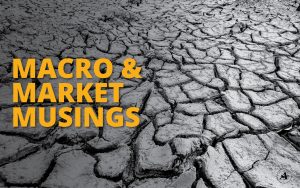Comments based on information available as of 5:45am CT on 5/30/2025
Growth: Fissures Forming
Initial jobless claims have moved up, private sector payroll growth has slowed, and even service sector activity has slowed. Layoffs have been announced by some of the biggest companies. Policy uncertainty is leading to hesitancy and that is weighing on growth. The market is a leading indicator of the economy, not vice versa. The market is saying that despite the uncertainty, we’ll get some clarity soon. The economy is likely to follow the market higher.
Inflation: Hot Potato
Who pays for tariffs? Mechanically, importers pay the bill. Economically, it gets passed around like a hot potato. Thus far, companies that export to the US haven’t cut their prices. Instead, they’ve diverted their products to other countries. The New York Fed said three-quarters of businesses have passed along some, or all, tariff costs to consumers by raising price. To the extent they don’t, margins can take a hit. The bigger threat to the markets isn’t necessarily slower growth so much as it’s narrower margins.
Policy: Dazed and Confused
Investors are stuck in limbo. Is the growth data weak enough to speed up rate cuts by the Fed or not? Will courts force tariffs to stop until a trial can be held? Will Trump and Xi hug and make up? What about Trump and Musk? Is the One Big Beautiful Bill becoming one big mess to pass? The market is saying we’ll be fine. And we probably will be.
Looking Ahead: Value Distortion
One of the popular metrics of “value” is the price-to-earnings ratio. It’s no replacement for an actual valuation, but it is a common shorthand. Sometimes it is based on trailing earnings (based on fact) and sometimes it’s based on consensus expected earnings (based on hope). After the stock market has bottomed, the backward-looking measure can look too high as earnings fall and prices rise. This is because prices fell in anticipation of lower earnings and begin to rise in expectation of a return to growth. Similarly, Wall St. analysts tend to ratchet down their expectations after prices fall, so even forward-looking price-to-earnings ratios can look too high. Prices rise before earnings improve and before Wall St. can get optimistic (or realistic) again. This is why these simple metrics can be a little too simple to be useful.